Norbiton (19)
By:
April 9, 2021
Anatomy of Norbiton: Geographical
‘Give me water from three or four great rivers of this country’, an old Indian from the Javita mission said, ‘and I will tell you by tasting them where they come from; whether it is a white or black river, whether it is the Atabapo, Paragua, or Guaviare.’ European Geographers are wrong not to admit to seeing things as Indians do, for they are the geographers of their own country.”
Alexander von Humboldt, Personal Narrative of a Journey to the Equinoctial Regions of the New Continent, p.221
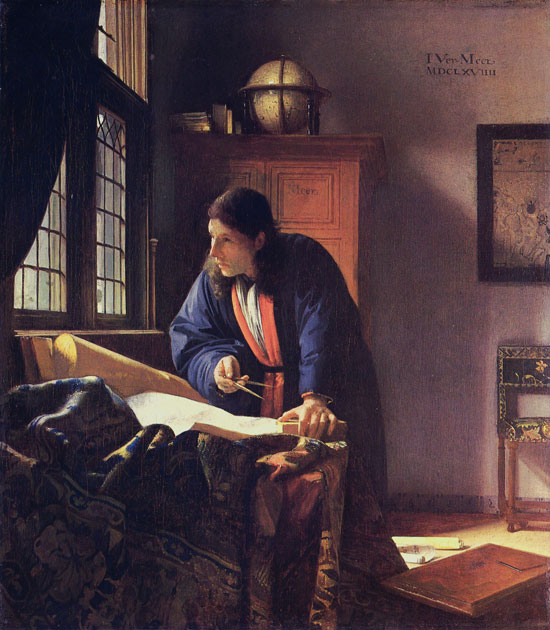
– THE GEOGRAPHER
JOHANNES VERMEER
We know what NORBITON: IDEAL CITY is, considered as a discrete and local entity, just as we know what Renaissance Florence was. But we are occasionally forced to consider where and how it is situated in Global Space—how, for example, it makes itself known to Geographers.
Geography is at once an empirical endeavour—the geographer stands on solid earth, he kicks at stones and refutes the Ideal City, thus—and a practice grounded on the rational but fallacious presupposition of a uniform, homogenised, extensible space over which an invariable set of processes continually operate.
Fallacious, because there are as many geographies in the world as there are yards of earth upon which an autonomous being may squarely stand. Quantify something strange, and quantity itself will creak and bend.
Nevertheless, as a practice, geography represents one plausible way of structuring our understanding of the properties of the World, or of the Ideal City, such that our emotional responses—awe, wonder, impotence—are properly absorbed.
By the time of his third voyage to the Americas in 1498, Columbus, enmeshed in a new and as yet invisible Geography, had begun to speculate about the location and proximity of the terrestrial paradise.
He had arrived, by his estimation, on the extreme eastern edge of the domain of the Great Khan, at or near Marco Polo’s Cippangu[1], and he knew that it was in the East that paradise had been located. The lands that he had seen were fecund, green, teeming, beyond belief.
Merely to open one’s eyes and look was a sensory experience so rich, so scrubbed of impurities, that the viaducts and sluices of the optic nerve and the processual centres of the brain were flooded, awash, seemed to lack capacity.
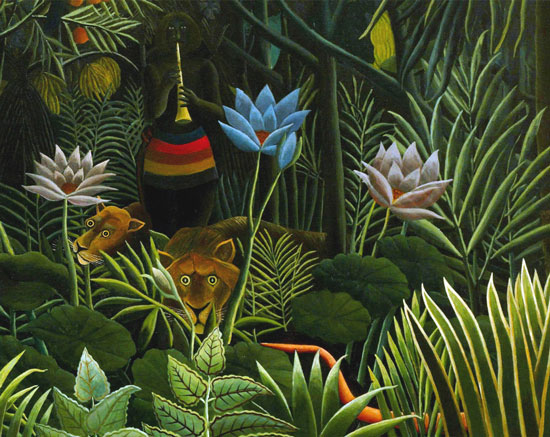
– THE DREAM (1910)
HENRI ROUSSEAU
He had seen, moreover, the mouth of the Orinoco, a river so vast that it must, he concluded, spring from Eden.
How he would have know that he had arrived if he had in fact pushed inland to the heart of the country is not stated. Perhaps the intensity of the beauty would have beaconed out like a radio wave so that he could make passes, attune himself, home in on the centre. But he might equally have passed through and beyond without ever really understanding what he was looking for.
Stephen Greenblatt, in Marvelous Possessions (1991), suggests that Columbus was in fact on the cusp of an idea bigger even than Eden—the extraordinary idea of a continent of land of which no one had ever conceived: the idea, in short, of South America. But this would have been a mental landfall of geographical proportions, and Columbus, a man of his times, fell back almost with relief on what I suppose could be called a global chorography.
The chorography of the cinquecento, as we have noted elsewhere, is a subset of geography or cartography which dealt with regional rather than global features of the earth and which was rooted in some remarks by Ptolemy in his Geographia.
Renaissance chorography could be either visual or written. The written form included haphazard bits of history, local lore, antiquarianism—anything, in short, that typified a region or city. The visual form was most usually a bird’s eye view of a city, or a plan view with illustrative or interesting buildings in elevation.
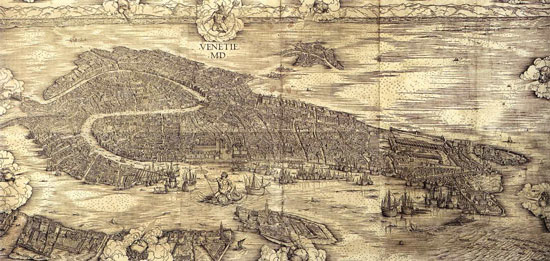
– CHOROGRAPHICAL VIEW OF VENICE
JACOPO DE’BARBARI
The obliquity of the visual form, note, by which the revelation of structure simultaneously conceals, is mirrored in the obliquity of the written form, which is arbitrary, accidental, selective. Marco Polo famously makes no mention of tea, or printing. Columbus’s descriptions of the New World in letters to his sponsors draw attention to the fecundity and verdant wonders of the land but not to the paucity of its trade or his own unlocalisable misgivings.
There is, if we are honest, a chorographical drift in all of us.
The classical pedigree of Renaissance chorography is in fact a harmless fabrication: as a literary form, chorography has its roots in Medieval geography as explored in the travels of Sir John Mandeville or Marco Polo. Medieval geography is clumpy, relational, not homogenised. It is a juxtaposition of chorographies, not a rationalised endeavour. Space is not evenly distributed, it is neuronal. There are journeys and destinations. Each destination does a different thing. This city excels in that, that city in this. Here you find excellent yaks. There the amber is unparalleled, and a Venetian groat of silver will buy you three pheasants.
Marco Polo was a merchant (or at least the youngest scion of a family of merchants). His voyage of exploration, in which he encountered wonders and marvels, was a voyage in prospect of trade. The wonders he most frequently notes are economic, lucrative.
The fruits of exploration, and by extension of trade, are a portable wonder. Dürer, on a visit to Antwerp and Brussels in 1521, saw items displayed which had been brought back from the Americas, and noted in his journal as follows:
“I also saw the things that were brought to the King from the new land of gold: a sun entirely of gold, a whole fathom wide, and a moon entirely of silver, of equal size, likewise two rooms of rare accoutrements, of all manner of their weapons, armour, bows and arrows, wonderful arms, strange garments, bed hangings and all manner of wonderful things for many uses, all much fairer to behold than any marvel. These things are all so precious that they are valued at one hundred thousand guilders. And in all the days of my life I have seen nothing that has so rejoiced my heart as these things. For I saw among them strange and exquisitely worked objects and marvelled at the subtle genius of the men in distant lands. The things I saw there I have no words to express.”
Similarly, in Star Trek, the physical world is populated with the superior products of distant worlds: Jimbalian fudge, Malkothian wine, Orion slave girls.
The more marvellous and strange the explored is, the more we attempt to wrestle it into a chorographical shape, a discursive and arbitrarily unordered list of singular attributes and trade goods, wherein it no longer matters that we have ‘no words to express’.
Hunter Sidney, I discover, has an interest in New World flora, specifically New World orchids—and even more specifically, tropical new world orchids, such as, for all I know, these.
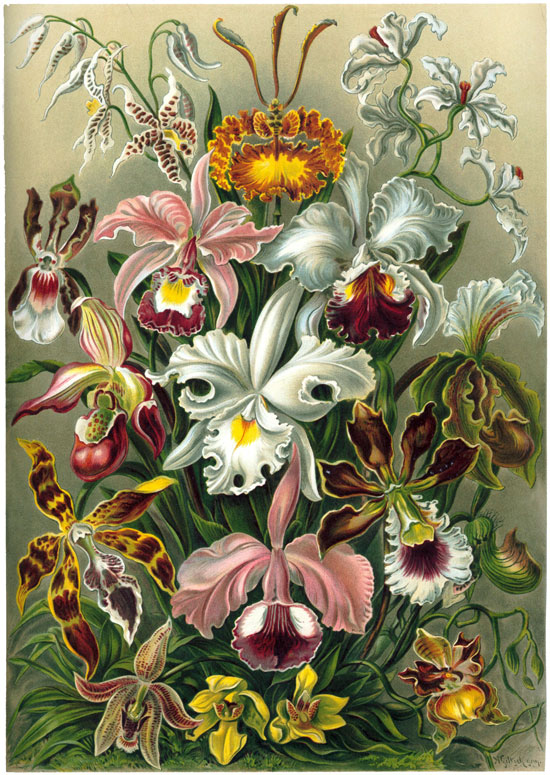
– KUNSTFORMEN DER NATUR (1904)
ERNST HAECKEL
This is surprising to me, only because he has never said anything about it in all the months I have been gardening, has never, in fact, so much as mentioned a plant. And it is especially arresting now because he takes me for the first time through his Spartan kitchen at the back of his house, occluded with green stuff at its window, into his small garden.
His garden, he says, is a experiment in constructive sanity gone somewhat awry and realised for no particular reason as a small and hyper-compressed jungle.
The compression is made possible by Hunter Sidney’s careful organisation of it into pots and zones and levels. The only plants are broad leaf succulents, forest creepers, stumpy trees with goitred trunks. There is no lawn, but a round iron table and a pair of matching chairs are placed on some paving slabs in the putative centre of the space, encroached on by trailing vines, nodding branches.
There is a greenhouse which runs the length of one side more or less, and this is filled with trays of propagating seedlings, some sweating jungle plants and rickety epiphytic bromeliads, and a row of tomatoes yoked to canes, fat with green fruit, in motionless concentration.
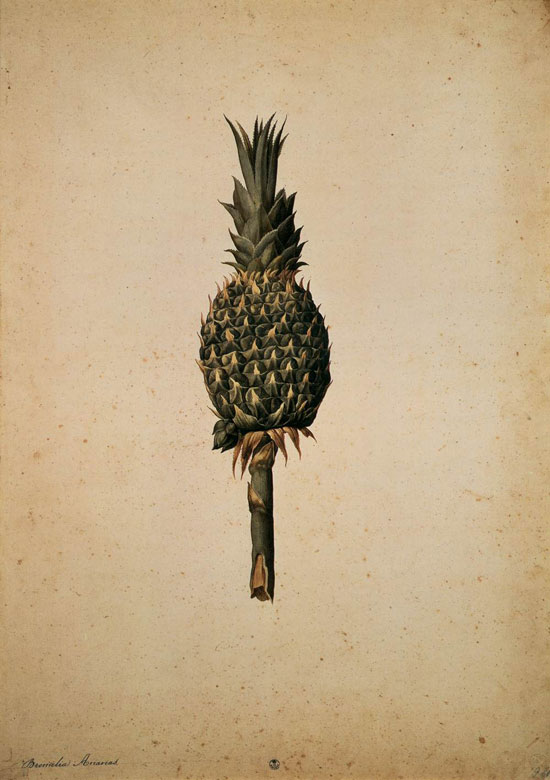
– PINEAPPLE
JACOPO LIGOZZI
And the orchids, his interest in which he explains to me as a sort of accidental specificity.
He tells me that he inherited the garden from his wife when she left him. She cleaned out the greenhouse like Alfonso II fleeing Naples, taking with her sacks full of tulip bulbs and uprooted flowery things, leaving only a few Ecuadorian orchids which he had given her not long before, a guilt-laden impulse-buy at a flower shop in Kew.
At the time he had, he says, and in fact still has little interest in flowers, aesthetic, scientific or otherwise, and is aware that they are colourful and pretty more by reputation than by direct perception.
He might very easily have left them to die. But their physical presence offered, in a way, to fill the vacant time now allotted him, and so he began, slowly, to string orchids out along his greenhouse benches, and little by little to replace the bolted and outgrown herbaceous plants of his wife’s confection in the garden outside with the tropical and largely flowerless greenery that, in a modest way, pleased him. He found that he enjoyed stretching himself out over a space in a way that was not fully determined—his definition, I take it, of gardening.
Thus from these lonely emblems of loss and collapse had sprung his small but coherent collection. The orchidaceae, he tells me, are by some measures the most numerous family of monocots—or indeed of angiosperms in general—on the planet, numbering some 26000 species; and certainly the most widely distributed. Thus orchids, in themselves, are not an interest. They require further shaping. It is, otherwise, as though you were interested in everything. Orchids, in plantsman’s terms, tend to infinity.
Hunter Sidney explains, therefore, that his interest is geographically circumbound, and centred on three habitats—coastal mainland, tropical lowland, and tropical highland, between latitudes of roughly 4 and 12 degrees N, with an exceptional dip to 4 degrees S in Ecuador.
This, he says, pointing to a sickly-looking purple affair whose name I cannot remember, might have been Columbus’s buttonhole on his third voyage, when he lingered in the Gulf of Paria between Trinidad and the delta of the Orinoco.
I ask if he has ever been to South America and he laughs, insofar as he is able to laugh; yes, he says, Venezuela, in my days as an oilman. I didn’t see a single flower!
There is an unknown woman sitting at the table in the garden on the occasion of this, my first visit, a woman of about forty, I suppose, whom Hunter Sidney introduces as Veronica; Veronica then quietly corrects this to Monica (although Hunter Sidney persists in calling her Veronica).
I rapidly understand that the history I am granted of Hunter Sidney’s garden and greenhouse is peripheral to this woman’s presence—that is, we are hugging the coastline of the garden rather than striking out across the ocean of other possible topics. I say this because when she has gone off, Hunter Sidney tells me that Veronica is the daughter of Ted Kelley from a former life and asks me not to mention her presence in his garden either to Kelley or his wife, and certainly not to Clarke, who is not discreet.
What I do not understand until much later still is that I have collided with an unknown continent on the fringes of empirically real Norbiton (Hunter Sidney’s house and garden, like mine, are in Canbury) but in the heart of NORBITON: IDEAL CITY, where continent, it transpires, can overlay continent; and that my understanding of its geography is about to undergo an imperceptible and deferred but nonetheless cataclysmic Redistribution Event.
Columbus never really made the leap into the unknown—the recognition of the idea of America—that his discovery called for. In the accounts he gave of his visits he attempted, as we have seen, to reconcile Ptolemaic geography with the anecdotes of Marco Polo and Sir John Mandeville, the biblical and apocryphal accounts of creation, and his own experience. But, for all his putative mysticism, his was the mental world of a practical mariner nurtured on portolan charts describing familiar or knowable edges, bays, inlets, deltas, river mouths, cliffs, reefs, sandbanks and prevailing winds. He carried the chorography of his origins (Genoa, Portugal, Spain) about with him in his ship, and arrived in the new world firmly ensconced in the old.
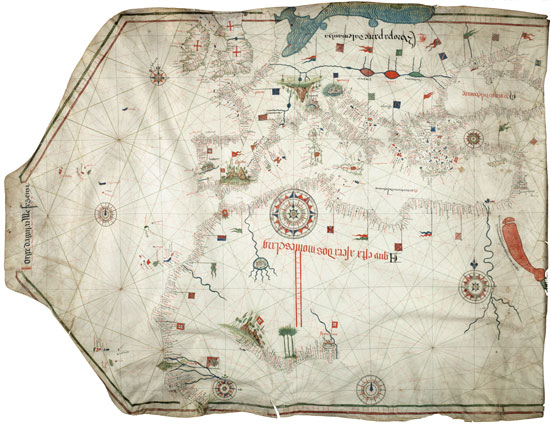
– CHART OF THE MEDITERRANEAN, WESTERN EUROPE AND AFRICAN COAST (1492)
JORGE DE AGUIAR
The Old World was developing systems for dealing with unknown lands.
The Portuguese, having set sail from the gloomy medieval fringes of Europe intent on creeping around the edges of the African continent, had adapted the techniques of the portolan chart to their explorations. They clung to the margins of the land, establishing trading factories along the coast which tapped into and slowly started to shape the barely understood but pre-existing trade networks of the interior.
Columbus had spent ten years in the pay of the Portuguese and had seen their African venture for himself, and this was the model he initially sought to impose on the Americas. But when, somewhat to his mystification, he found himself in an extensive archipelago with no recognisable trade patterns, he sought to draw on another Portuguese model, the exploitation of the uninhabited Atlantic islands (Madiera, Porto Santo, the Azores etc.), whereby colonists were left to till the land and farm domestic animals, perhaps mine available resources. The fortuitous foundering of the Santa Maria provided him with a ready-made colony of sea men and timber, and La Navidad, the first abortive settlement, was created.
The course of appropriation was set. Columbus was expected to claim new lands in the name of the Spanish crown, and to do so through a clearly stipulated set of rituals. Each claim had to be notarised and witnessed, and a copy of the notarised document sent back to Spain and lodged there in the legal record. Columbus was quick to note that no one objected when he carried out these ceremonies—by no one meaning no rival power, not the local natives. This no one is in effect a legal fiction. The European legal framework was being extended over this newly homogenised space, but not its unhomogenizable, elusive, passive, cannibalistic, diabolical, unresourceful inhabitants.
The pattern continued with the pioneering barbarism of the conquistadors.
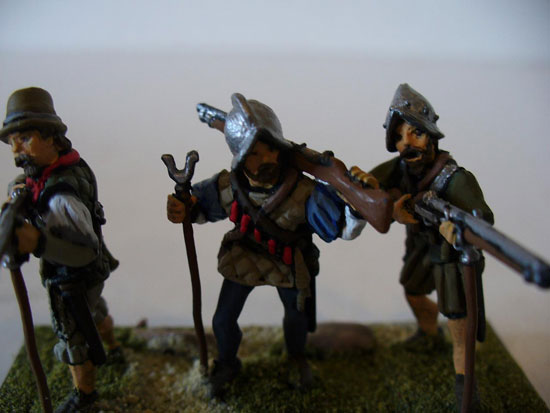
In Mexico, Hernán Cortés elaborated grandiloquently on the rituals of appropriation, the personal blazon of gesture mingling easily with the requisite legal theatre:
“Cortés, we are told, ‘moved walking on the said land from one part to another, and throwing sand from one part to another, and with his sword he struck certain trees that were there, and he commanded to the people who were there that they should have him for governor of His Majesty of those said lands, and did other acts of possession.'”
The place of the conquistadors was in time taken by the creeping solicitude of the missions. The missions were emblematic, almost, of the need to draw the unknown and unknowable jungle systems of South America into the more temperate European World Pattern.
However, the Unknown very sensibly rebuffed any such attempt. Whatever success they may have had at a local level—converting the natives—the old sacred geographies were now defunct. At the beginning of the nineteenth century, Alexander von Humboldt, making his first passes into the South American interior and coming into contact with the Chaymas, an inland tribe firmly in the hands of the missionaries ‘witnessed a monk “violently agitated in proving, that Infierno, Hell, and invierno, winter, were not the same thing.”’
Humboldt, gifted with the true geographer’s capacity for irony, concludes in his journal that “they have been rendered stupid by the effort to render them obedient,” a sentiment of which Foucault, no doubt, would have approved.
Montaigne, in the Apology for Raymond Sebond, uses the discovery of the Americas to demonstrate the instability of our knowledge of anything:
‘Ptolemy was a great figure; he established the boundaries of the known world; all the ancient philosophers thought they had the measure of it, save for a few remote islands which might have escaped their knowledge. ….But now that in our century new discoveries have revealed, not the odd land island or the odd individual country, but an infinite landmass, almost equal in size to the part we already knew, geographers today proceed to assure us that everything has really been seen and discovered this time… Is it not more likely that this huge body which we call the Universe is very different from what we think?’
The shock of redistribution was such that there is plainly no such thing in the cinquecento as an established iconography of the discovery of the Americas. Instead we are treated to riffs on old themes, such as this altarpiece by Alejo Fernández, the earliest painted celebration of the event, from some time before 1536, known as the Madonna of the Navigators.
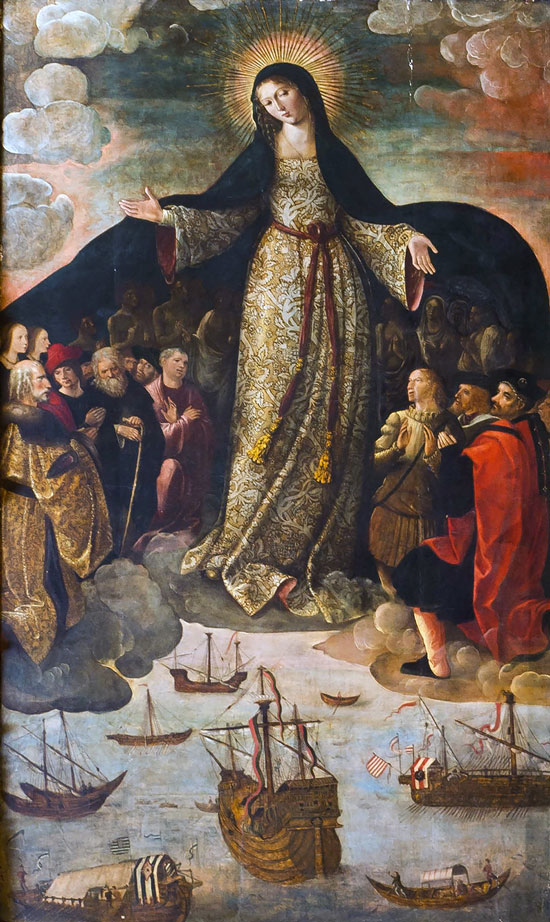
– MADONNA OF THE NAVIGATORS
ALEJO FERNÁNDEZ
It is a Madonna della Misericordia, a well-known formulation turned to bizarre new purpose. It is poorly executed (the stretch of the cloak, for instance, which does not so much billow as uniformly blanket the horizon; the figure of Charles V on the extreme right, who seems to be overbalancing out of the composition; the figure to the left of him which flickers insubstantially between foreground and middle ground, sharing a body intermittently with the Emperor; the cartoonish Christ-like profile of Columbus on the extreme right; and so on), but it is the thrash and clump of the intellect which generates supercilious wonder in the viewer, carracks and caravels floating not on the ocean but in indeterminate space, like a child’s sticker book of ships; the progenitors of the exploration huddled under the outspread cloak like fugitives from the eye of heaven. It is a mangled affair, one that shows us, perhaps, how suddenly irrelevant the old forms have become, how the stile nuovo of the quattrocento was really the Middle Ages progressed by other means. This is old stuff, not adapted to the Brave New World of global expansion.
The approach is not typical. In fact if we cast about for sixteenth century representations of the Americas we are almost certain to come up, instead, with something rather different.
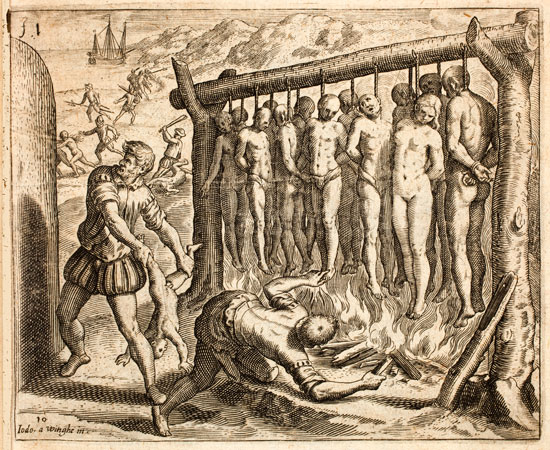
– THEODOR DE BRY, ENGRAVING FOR BARTOLOMÉ DE LAS CASAS’ NARRATIO REGIONUM INDICARUM PER
HISPANOS QUOSDAM DEUASTATARUM VERISSIMA, EDITION OF 1598
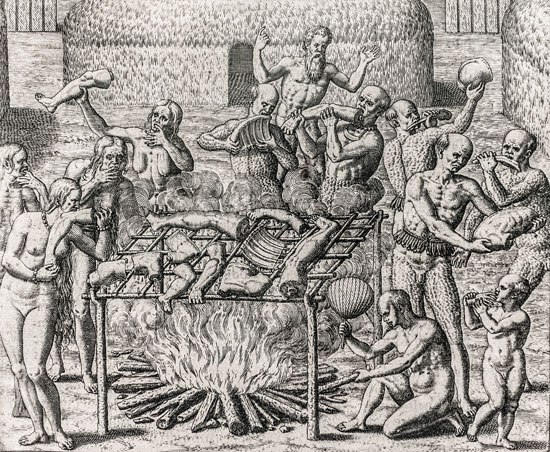
– CANNIBALISM IN BRAZIL, 1557, DESCRIBED BY HANS STADEN AND ENGRAVED BY THEODOR DE BRY
The woodcuts or engravings illustrating traveller’s tales and accounts of the new world, showing us its horrors, its wonders, its strangeness, its unfamiliarity, furnish our mental picture of these various early landfalls and encounters and observations which we summarise as discovery. The conquistador having gold poured down his throat, or scenes of conquistador atrocity, are, by now, a visual commonplace on a par with Mandeville’s monopods.
Michel Jeanneret, talking of the maps and atlases of the sixteenth and early seventeenth centuries, notes how the land masses—the Americas, the Great Antipodean continent—shift and bulge and shrink and disappear like clouds. So too these accounts, these illustrated tales, take bear-licked form in the monochrome of woodcut[2], as though only a pared-back, rough-hewn disegno can help us grope towards some satisfactory knowledge, and all the frescos and canvases and altarpieces of the sixteenth century, of Michelangelo and Raphael and Titian and Tintoretto, for all the marvel and wonder of their accomplishment, are antiquated modes of seeing adapted to an Old World of localized vortices: Rome, Florence, Venice.
As Alexander von Humboldt continued his explorations along the course of the Orinoco, he was borne down upon by a vast and anonymous tedium. He was fascinated by the lack of human agency in the heart of this jungle, but increasingly appalled by it. Day after day, he and his companions hauled their dugout canoe upriver; day after day nothing changed, but the world closed in around them. Their mastiff dog was hauled off into the jungle one night and, presumably, devoured. The jungle did not notice.
The world seemed to dissolve around him. He had come to a place where he could reach out and touch the objects he wished to understand, he could see the very centre of the target of his excursus—the locus amoenus, if you like, of a naturalist, a geographer—with his own eyes, day after day; but he could not grasp it, it had to be translated for him. His Amazonian guides, through whom he was forced to comprehend this world, could not see it as he did. He was interested in the flowers of trees, as only through their flowers could he categorise them according to the Linnaean system: his guides, fluent in the taste of the wood and the shape of the leaves, denied that the trees had flowers, even as they trod them under foot.
In this infinite jungle, Humboldt noted, there was no way of understanding your location, except by the stars, which were often invisible through the stifling airs. You might be anywhere. Wherever you stood was nothing more than an interchangeable intersection with everywhere else. It was a torment of insects, inertia, similitude, boredom.
Columbus, it transpired, had not discovered the approaches to Eden, but a road to the perfect centrelessness of geography. Unless these were one and the same thing.
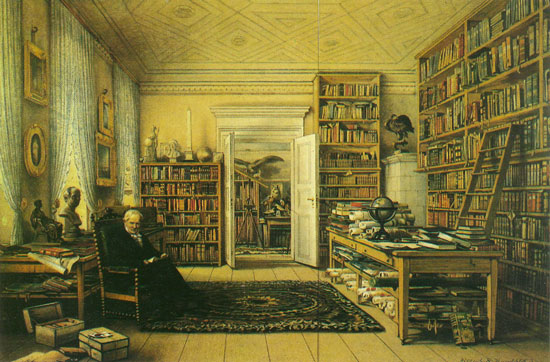
– ALEXANDER VON HUMBOLDT IN HIS LIBRARY
EDUARD HILDEBRANDT
There comes a point where you can no longer ignore the implications of a rift in geographical space. Just as Florence in the cinquecento faced not only a rapid shift of power (and artistic activity) on the Italian peninsula in the direction of Rome, but also a long-term drift of economic activity in Europe as a whole away from the Mediterranean and towards the north and west and the Atlantic seaboard; so too in Norbiton, it is likely or perhaps inevitable that the Ideal City of the Failed Life will eventually be engulfed by wider geographical realities.
Norbiton, like all cities, lends itself most comfortably to a chorographical account, and that is what we have given in the Anatomy. Thus we have outlined a skein of interrelated locations and landscape features—towers, rivers, bridges, what you will—each related to each by routine, function, commonality, propinquity, and the whole supporting in turn a complex and unstable but satisfying social organisation. This is the Ideal City. Described thus the city and its citizens seem no more than a granule of geography, not exactly an indivisible particle but a relaxed jumble of geographical stuff, within which there can be no shock of the unusual, no tectonic revaluation.
But if we accept, first, that NORBITON: IDEAL CITY is a potentially valid answer to the question Where?, and second, that seeking to answer the question Where? is one of the defining characteristics of geography, then we are bound at some point, like it or not, to have that question asked and answered—whether from within or without is irrelevant—and to take our place in consequence in the World-at-Large.
What is this World-at-Large to us? In the same way that Columbus, in discovering America, brought Europe up against twin continents of land and numberless tribes of people—cannibals or Aztecs—entirely untouched by narratives of Christian salvation hitherto rooted in a logic (perhaps logic is the wrong word) of universality; so we, in peering out on the World-at-Large, discover that we are nothing to it. No one is. The World-at-Large, whether real or virtual (and we discover the incomprehensible forests of the Americas every time we open a browser), is only patterns emerging from the chaos of markets, societies, interactions; it is—perhaps refreshingly, certainly disconcertingly—beyond redemption.
Like the Santa Maria or the Enterprise, the Ideal City was always to us an uprooted, unanchored entity, a vessel in which we could make constant sail for new lands. But if so, then we had thus far advanced by an unconscious, routine system of dead reckoning and minor pragmatic course corrections. Now we face the prospect of new stars appearing in the sky, new continents in our path, a landfall tantamount to a foundering, a spilling of the crew, on the shore of the World-at-Large, there to encounter an exotic geography of other people: their landfalls and interiors, their opulent fruits, their networks of riverine trade, their cannibal tribes.
I like to think that the Paradise which Columbus imagined on his third voyage, cruising the delta of the Orinoco, was emblematic of a place that would assimilate him, rather than the reverse. Here was a place that he could not bind in trade or servitude, but into the vast indifference of which he would himself dissolve, like Humboldt centuries later.
Perhaps, to return to ideas I formulated at the outset of the projects, we could occupy the World-at-Large like invisible Amazonians, dissolve into it. Rather than merely know it as an overarching or underlying Idea, we could daily enact it, hapless Failed Geographers of the World-at-Large.
When I was seventeen I went on a geography field trip to Cornwall for a week. One of the things we did there was make a morphographic map of a small river valley just by the sea. There were no roads or paths in the valley, only the river. The valley was steep-sided and thigh-deep in gorse; lower down, the river had etched some tiny terraces. The technique was to walk a line traversing the valley from one side to the other, taking measurements with a twenty-metre tape and a sort of plastic gun with which we could get approximate angles of slope; we would measure the distance to the next break in slope, take the angle, note it on a chart on a clipboard, and continue.
We walked the lines in pairs. I was paired with a pretty blonde girl called Jane. We’d barely spoken until that day, and I don’t suppose she can recall anything about me now. She giggled a lot and acted it up much like Daisy Buchanan might if you dropped her in the jungle in her heels and chiffon. I patronised her accordingly, and we got on just fine.
It was a blustery day, but sunny, and I enjoyed tramping about with her in the gorse. At one point our tape measure snapped off at its base while I was shouting at her to pull it tauter, tauter, and we carried it around thereafter like a big spaghetti from one break of slope to the next, where we would painstakingly disentangle it from itself and the gorse. The chart on the clipboard got soiled, creased, torn. We filled it in wrong and scratched out our entries and emended them on the fly in illegible biro or blunt pencil. We were useless. The other pairs worked their way crabwise, efficiently, up and down the valley, and we fell behind. I remember our teacher—bearded, sneering, aggrieved—staring at us hands on hips from across the valley, waving some instruction, shouting something inaudible; we might have been walking emblems in a Fellini film, locked into our richly pointless task, incommunicable, vaguely happy, stupid.
The map, if it ever got made, got made no thanks to us. But I remember that day in the valley as though it were yesterday, and the valley pretty well too.
What Jane and I were doing was not geography. But this is anyway (or perhaps consequently) how I would like to conduct the geography of the Ideal City as it relates to the World-at-Large: in good humour, and tending to no outcome in particular. A continual mapping of an infinite, because unvarying, landscape.
Who knows, we might dissolve into the World, as Humboldt into the forest, as Jane and I into the hillside, each square hundred foot of land a metonym for the entirety of the universe. We would become, fancifully I suppose, the source and projection of our own wonder.
Footnotes ☞
1 Columbus had identified Cuba as Cippangu (Japan). He first made landfall at Bermuda, and then at Hispaniola (Santa Domingo and Haiti). ⏎
2 This is not strictly true. The woodcuts of Theodor de Bry (1528-1598) for example were based on watercolour illustrations by John White, Jaques le Moyne de Morgues and others (de Bry himself never crossed the Atlantic), and in subsequent editions they were often tinted. However, I think it is fair to say that we are a long way from Titian. ⏎
Anatomy of Norbiton on HILOBROW
Original post at Anatomy of Norbiton: Geographical
Anatomy of Norbiton
Short Life in a Strange World by Toby Ferris
Toby Ferris on Twitter
On the Paintings of Pieter Bruegel by Toby Ferris
All tapir illustrations by Anna Keen: portfolio

